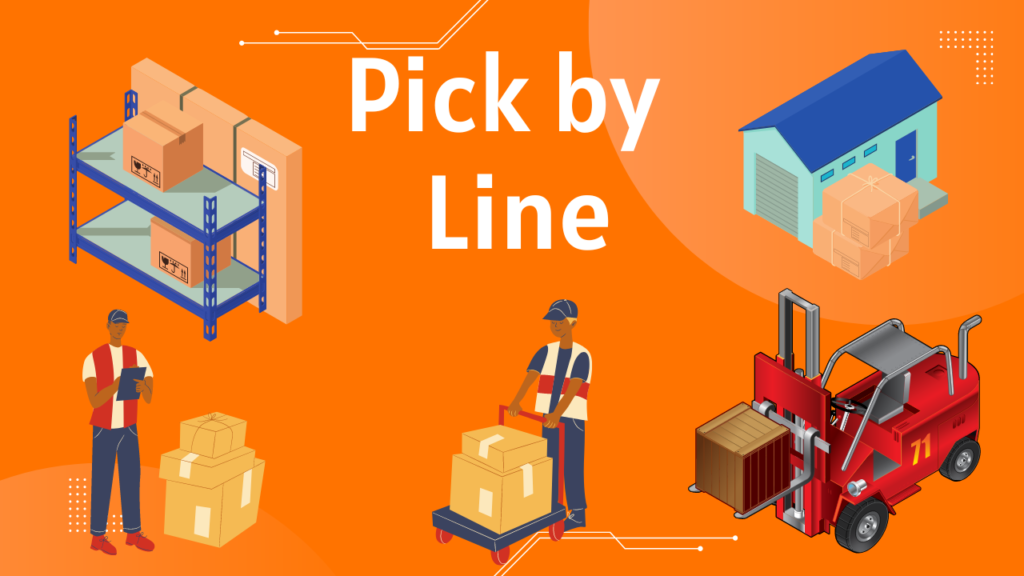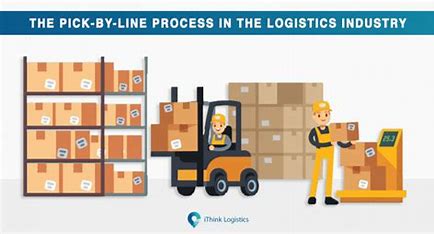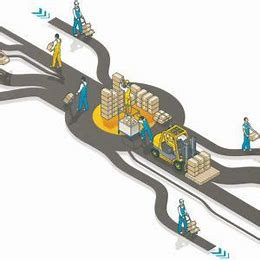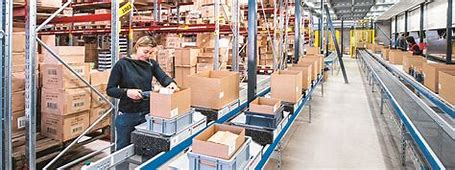Pick-by-line is a method used in logistics for picking and fulfilling orders in a warehouse or distribution center. In this guide, we will explore the meaning of pick-by-line, its uses, and benefits, as well as how to implement it successfully into your warehouse operations.
What is Pick-by-Line in Logistics?

In simple terms, Pick-by-Line refers to the process of picking orders in a way that the picker follows a predetermined route or line. During the process, the picker moves along the line of products, picking the needed items until the order is complete. The pick-by-line process can utilize either manual or automated methods.
One of the advantages of the pick-by-line method is that it can help to reduce the amount of time it takes to pick an order. By following a predetermined route, the picker can avoid backtracking or going out of order, which can save time and increase efficiency.
In addition, the pick-by-line method can help to reduce errors in the picking process. By following a predetermined route, the picker is less likely to miss items or pick the wrong ones. This can help to improve accuracy and reduce the need for returns or re-shipments.
Another benefit of the pick-by-line method is that it can be used in a variety of settings, from small warehouses to large distribution centers. This flexibility makes it a popular choice for many businesses that need to fulfill orders quickly and accurately.
Furthermore, the pick-by-line method can be combined with other technologies, such as barcode scanners or voice picking systems, to further increase efficiency and accuracy. These technologies can help to speed up the picking process and reduce the likelihood of errors.
Overall, the pick-by-line method is a popular and effective way to pick orders in logistics. Its ability to reduce time and errors, as well as its flexibility and compatibility with other technologies, make it a valuable tool for businesses of all sizes.
The Uses for the Pick-by-Line Method
The pick-by-line method is a popular picking strategy used in warehouses and distribution centers worldwide. It is suitable for businesses that handle several small orders with multiple items each day. This method significantly minimizes the picker’s travel time by organizing the picking process in a predetermined route, which saves time and reduces labor costs for businesses.
The pick-by-line method is a highly efficient way of picking items as it ensures that the picker follows a specific route through the warehouse, picking items as they go along. This method reduces the time taken to pick items, and it also ensures that items are not missed or skipped in the picking process, reducing the risk of errors in filling orders.
One of the significant advantages of the pick-by-line method is that it optimizes inventory management. This method ensures that items are picked from the correct location, reducing the time taken to locate items and improving the accuracy of inventory records. This method also reduces the processing time for orders, leading to higher accuracy and increased productivity in the warehouse.
The pick-by-line method is also highly flexible and can be customized to suit the specific needs of a business. This method can be used for picking items in a variety of different warehouse layouts and can be adapted to suit businesses with different order volumes and product types.
Overall, the pick-by-line method is an excellent choice for businesses that want to improve the efficiency of their warehouse operations while reducing labor costs. This method ensures that the picking process is organized and optimized, leading to higher accuracy, increased productivity, and improved customer satisfaction.
Managing Workload

Managing workload is a critical aspect of warehouse management, and the pick-by-line method is an excellent tool that can help warehouse managers manage their staff more effectively. By pre-assigning routes and the number of orders that each picker is responsible for, warehouse managers can ensure that their resources are utilized efficiently, and workload is distributed evenly among the staff.
One of the significant advantages of the pick-by-line method is that it enables warehouse managers to optimize their workforce and ensure that each staff member is assigned tasks that match their skill set. For instance, a picker with excellent organizational skills may be assigned to handle orders that require more attention to detail, while a staff member with a faster picking speed may be assigned to handle orders that require quick processing.
Moreover, the pick-by-line method provides warehouse managers with data about each picker’s performance, which enables them to identify areas that need improvement and make necessary corrections. For example, if a picker is taking longer than usual to complete their assigned tasks, the warehouse manager can investigate the issue and provide additional training or support to improve their performance.
Another benefit of the pick-by-line method is that it helps warehouse managers to reduce errors and improve accuracy. By assigning specific routes and orders to each picker, the chances of mix-ups and errors are significantly reduced, leading to better outcomes for the business.
In conclusion, the pick-by-line method is an excellent tool for managing workload in a warehouse setting. It enables warehouse managers to optimize their resources, improve accuracy, and identify areas that need improvement. By utilizing this method, businesses can streamline their operations and achieve better outcomes.
The Benefits of Pick By Line Process
The pick-by-line process is a popular method used in warehouses for picking and packing items. It involves using a predetermined route to guide workers through the warehouse, ensuring they pick the correct items in the correct order. This method has numerous benefits that can help improve warehouse efficiency and productivity.
One of the main benefits of the pick-by-line method is increased picking efficiency. By providing a predetermined route, workers can quickly and easily navigate the warehouse, reducing the time it takes to find and pick items. This can lead to faster order fulfillment and increased customer satisfaction.
In addition to increased efficiency, the pick-by-line method also improves picking accuracy. By following a predetermined route, workers are less likely to make mistakes or pick the wrong items. This can help reduce the number of returns and improve customer satisfaction.
Another benefit of the pick-by-line method is better inventory management. By using a predetermined route, warehouse managers can easily track which items have been picked and which items still need to be picked. This can help reduce the risk of overstocking or understocking items, which can lead to lost sales or excess inventory costs.
Furthermore, the pick-by-line process provides valuable data to warehouse managers that can be used to optimize the process further. By analyzing data on picking times, order accuracy, and inventory levels, managers can identify areas for improvement and make data-driven decisions to improve warehouse efficiency.
But that’s not all. The pick-by-line method also helps reduce employee fatigue. By providing a predetermined route, workers don’t have to spend as much time searching for items in the warehouse, which can be physically demanding and tiring. This can help create a safer work environment and reduce the risk of workplace injuries.
In conclusion, the pick-by-line method is an effective and efficient way to manage warehouse inventory and improve productivity. By providing a predetermined route, workers can quickly and accurately pick items, while warehouse managers can use data to optimize the process and improve efficiency even further.
Also checkout the importance’s of the Fulfillment Companies
The Pick-by-Line Process in the Logistics Industry!

The pick-by-line process is a popular method used in the logistics industry to make warehouse processes more efficient. It involves the picking of items from a warehouse based on a customer’s order, where the items are arranged in a specific sequence on a conveyor belt or cart.
The pick-by-line process is particularly well-suited to e-commerce warehousing, where there is a high volume of orders with multiple items. With this method, each item is picked separately, ensuring that all items are accurately picked and packaged for shipment.
One of the key benefits of the pick-by-line process is that it can significantly reduce processing time, especially during peak seasons like holidays. This is because the process allows warehouse managers to pick multiple orders at once, rather than picking each order individually.
Another advantage of the pick-by-line process is that it can help warehouse managers to meet their customers’ demands and keep up with the competition. By using this method, warehouse managers can ensure that orders are processed quickly and accurately, improving customer satisfaction and loyalty.
In addition, the pick-by-line process can also help to reduce errors and improve inventory accuracy. By picking items one at a time, warehouse staff can ensure that each item is correctly identified and picked, reducing the risk of errors and improving inventory accuracy.
Overall, the pick-by-line process is an effective method for improving warehouse efficiency and meeting customer demands. With its ability to reduce processing time, improve accuracy, and increase customer satisfaction, it is a valuable tool for warehouse managers looking to stay competitive in the logistics industry.
Understanding the Principles of Pick-by-Line

While the pick-by-line method may be fairly simple in concept, several principles underlie its implementation. The first principle is that the warehouse managers should group items in a way that they are picked in the most efficient order.
For example, if a customer has ordered a set of kitchen utensils, it would be most efficient to group all the utensils together, rather than having them scattered throughout the warehouse. This reduces the time it takes for the picker to locate and pick all the items, ultimately increasing the efficiency of the pick-by-line method.
The second principle is that the picker must receive the pick instructions at the appropriate station. Therefore, optimizing the use of the pick software or hardware will minimize the chance of missed or skipped orders.
One way to optimize the use of pick software is to ensure that the software is integrated with the warehouse management system. This integration allows for real-time inventory tracking, which can alert the picker if an item is out of stock or in a different location.
In addition, the use of wearable technology, such as smart glasses or wristbands, can further optimize the pick-by-line method. These devices can provide pickers with hands-free access to pick instructions, reducing the chance of errors and increasing efficiency.
Another principle of the pick-by-line method is the importance of proper training for pickers. Warehouse managers should ensure that pickers are trained on the software and hardware used in the pick-by-line method, as well as on proper picking techniques.
Proper picking techniques include using the correct picking equipment, such as carts or pallet jacks, and following safety protocols to prevent injury or damage to inventory.
By following these principles, warehouse managers can ensure that the pick-by-line method is implemented efficiently and effectively, ultimately improving the overall productivity of the warehouse.
Implementing Pick-by-Line in Your Warehouse

Implementing the pick-by-line method requires careful planning and execution. One of the first steps is to analyze your warehouse’s operations and identify areas that need improvement. The next step is to train the staff on the new method of picking orders. This could involve on-the-job training or classroom sessions for a large group of workers.
Additionally, implementing the pick-by-line process may require upgrades to your warehouse’s infrastructure, such as installing new racks, conveyor belts, and barcode scanners. You may also need to invest in pick software or hardware and train your employees on how to use it.
Integrating Pick-by-Line into Your Workflow
The pick-by-line method can be integrated into your workflow efficiently, leading to a more organized and streamlined order fulfillment process with minimal errors. This results in increased customer satisfaction, reduced labor and processing costs, and more effective inventory management.
In conclusion, implementing Pick-by-Line in your warehouse can significantly improve your order fulfillment process, leading to increased productivity, greater efficiency, and better customer satisfaction. By following the principles of Pick-by-Line and training your staff on the process, you can streamline your operations and achieve greater success in the logistics industry.
